Jackfruit
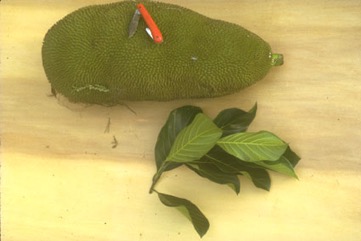
A tropical plant. It grows in the tropical lowlands and up to about 1200 m altitude. It grows in Nepal up to 800 m altitude. It can stand some drought, but not water-logging. Trees do best where there is year round rainfall. An annual rainfall between 1,000-2,400 mm is best. It yields poorly where humidity is low. It does best in a well drained, frost-free location that is warm and sunny. They are slightly more tolerant of cold than breadfruit. It suits areas with a temperature range 22-35°C. Trees can survive occasional frosts down to 0°C. It is best with a pH of 6-6.5. They have some wind and salt tolerance. It grows between 25°N and 30°S. In XTBG Yunnan. It suits hardiness zones 10-12.
Also known as:
Ampalibe, Banun, Bu luo mi, Cempedak hutan, Ekifenensi, Herali, Jaca-dura, Jaca-mole, Jaca, Jacquier, Jak, Jakobo, Jangphong, Jaquero, Kaathal, Kaihal, Kanoon, Kanthal, Katahal, Katahar, Kathal ke beej, Kathal, Katthar, Khanum, Khanun, Khatal, Khnaor, Kifenensi, Kos, Kothal, Kulu jaka, Lamasa, Lamkhong, Lamkhuang, Langka, Long di biu, Ma mi, Mak lang, Makmi, Malasa, Ma mi, Mfenesi mfuu, Mfenesi, Mfenesi, Mi duo luo, Miiz hnang, Miiz, Mit, Moe ulu initia, Mung-dung, Murasabalam, Nangka, Ndung, Nongko, Pala, Pana, Panasa chettu, Pandicho, Panwe, Peignai, Peinne, Phanas, Pilaka, Pilapalam, Plavu, Podushi, Pohon nangka, Polos, Rima, Sakkeyo, Tak bela, Te mai rekereke, Thaiphlung, Theibong, Tshackka, Tsjaka, Uto ni idia, Varaka, Yaca, Yakobo
Synonyms
- Artocarpus brasiliensis Gomez
- Artocarpus heterophylla Lam.
- Artocarpus integer auct.
- Artocarpus integra Merr.
- Artocarpus integrifolius auct. non L.f.
- Artocarpus philippensis Lamarck
- Artocarpus maxima Blanco
- Polyphema jaca Lour.
- Saccus arboreus major Rumph.
Edible Portion
- Fruit, Seeds, Leaves, Flowers, Vegetable
Where does Jackfruit grow?
Found in: Africa, Amazon, Andamans, Asia, Australia, Bali, Bangladesh, Bhutan, Brazil, Cambodia, Cameroon, Caribbean, Central Africa, Central America, China, Congo DR, Cook Islands, Cuba, Dominica, Dominican Republic, East Africa, East Timor, Fiji, Ghana, Guam, Guianas, Guinea-Bissau, Guyana, Haiti, Himalayas, India, Indochina, Indonesia, Jamaica, Kiribati, Laos, Madagascar, Malaysia, Maldives, Mauritius, Mexico, Micronesia, Mozambique, Myanmar, Nauru, Nepal, Northeastern India, North America, Pacific, Pakistan, Papua New Guinea, PNG, Philippines, Pohnpei, Puerto Rico, Samoa, Sao Tome and Principe, Saudi Arabia, SE Asia, Sierra Leone, Sikkim, Singapore, Solomon Islands, South America, Southern Africa, Sri Lanka, Suriname, Tanzania, Thailand, Timor-Leste, Uganda, United States, Vanuatu, Vietnam, West Africa, West Indies, West Timor, Yap
Notes: Jackfruit wood is a useful timber. There are about 50 Artocarpus species. They are in the tropics and subtropics of Asia and the Pacific. It possibly has anti-cancer properties. Fruit are high in folates 53-84μg/100.
Status: Gaining importance in some areas of Papua New Guinea, such as the Sepik. At present it is mainly only the seeds that are eaten. In some areas of Bangladesh it is a very important food. It is a cultivated food plant. It is sold in local markets.
Growing Jackfruit
Cultivation: Trees are usually sown from seeds, but it is best to sow them in their final location as the plants don't transplant easily. They have a long delicate taproot which makes transplanting difficult. Fresh seed must be used (less than 4 weeks). If fresh seed are planted immediately they grow more quickly and more seeds germinate. It is better to use larger seed. The fleshy layer around the seeds should be removed. Seeds can be soaked in water for 24 hours to give better germination. It is best to sow seeds with the embryo pointing downwards and also with the narrow end pointing downwards. Seeds germinate in 3-8 weeks. A spacing of 12 m is suitable. Where trees are used as a wind break, trees are spaced 6 m apart. Air-layering can be used, and stem cuttings are also possible. Air layering is best done in the rainy season. Rooting hormones can be used to help roots develop. The shoots used for air layering should be 2-3 years old and brown in colour. To produce air layers, a small branch 3-4 cm across, is cut below a node and only part way around the stem. A ring 5-7 cm wide is cut and a layer of sand wrapped around the stem and covered with plastic. Using 1% IBA growth substances helps shoots to strike and form roots. Roots form in about 22 days and the stem can be cut off and planted after about 2-3 months. Because trees vary in their growth rate, how quickly they flower and fruit, and in the fruit quality, it is best to grow plants by using vegetative parts from good trees. This can be done by budding or grafting onto 12 month old seedlings already established in the field. Budding and grafting are not easy with jackfruit. Because the fruit develops on the trunk, early pruning to allow 2-3 trunks to develop is helpful. As well, trees can be topped to prevent them becoming too tall and large.
Edible Uses: The flesh of ripe fruits can be eaten raw. Unripe fruit can be cooked and eaten as a vegetable. They are fried in curries, preserved in syrup, dried, cooked in milk or made into alcoholic drinks. Caution: Alcohol is a cause of cancer. Unripe fruit are pickled. The seeds (5%) can be roasted and eaten. They are also boiled. (Some kinds have more seeds). The young leaves and flowers are edible. They are eaten mixed with chilis, fish paste, sugar, salt etc.
Production: Jackfruit is a fast growing tree. They can be 7 m tall by 3 years old. Trees begin bearing after about 8 years. The fruiting season lasts about 4 months in subtropical places, but fruit can be produced year round in tropical places. Fruit take about 100 to 120 days from when the flower is pollinated until a fully mature fruit is developed but can take another 4 months to ripen. Trees tend to have heavy crops every second year. Pollination is by wind but hand pollination has been used to improve the amount of fruit set. Fruit can be up to 50 kg in weight. Fruit change from green to yellow when mature. Up to 250 fruit can be produced each year on large trees. Fruit do not store well but can be kept in a cool store for 4-6 weeks at 11°-12°C and with high humidity.
Nutrition Info
per 100g edible portion| Edible Part | Energy (kcal) | Protein (g) | Iron (mg) | Vitamin A (ug) | Vitamin c (mg) | Zinc (mg) | % Water |
|---|---|---|---|---|---|---|---|
| Fruit raw | 94 | 1.5 | 0.6 | 30 | 6.7 | 0.4 | 74.5 |
| Seed boiled | 161 | 5 | 0.7 | - | 10 | - | 57.6 |
| Immature fruit + Seed | - | 1.6 | 0.1 | - | 13 | - | 85.8 |
| Leaves | 86 | 5 | 17.5 | - | - | - | 75.5 |
| Flowers | - | - | - | - | - | - | |
| Seed raw | 54 | 4.3 | 1.2 | - | 10 | - | 60.9 |
Jackfruit Photos

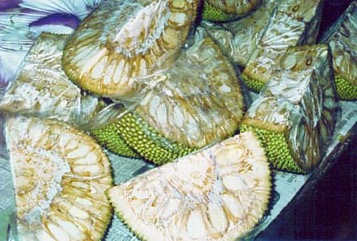
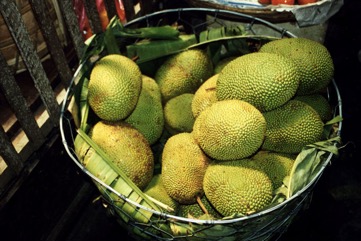
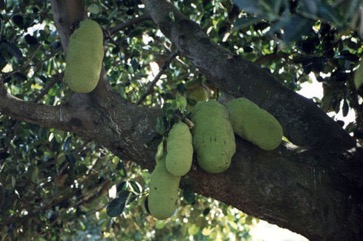
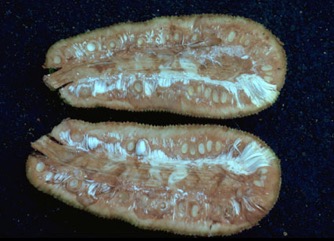
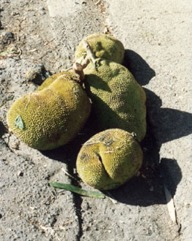
References
Jackfruit references
AAK, 1980, Bertanam Pohon Buah-buahan. Penerbitan Yayasan Kanisius, Jogyakarta. p 76 (As Artocarpus integra)
Abbiw, D.K., 1990, Useful Plants of Ghana. West African uses of wild and cultivated plants. Intermediate Technology Publications and the Royal Botanic Gardens, Kew. p 42
Ajesh, T. P., et al, 2012, Ethnobotanical Documentation of Wild Edible Fruits used by Muthuvan Tribes of Idukki, Kerala-India. International Journal of Pharma and Bio Sciences 3(3): 479-487
Alexander, D.M., Scholefield, P.B., Frodsham, A., 1982, Some tree fruits for tropical Australia. CSIRO, Australia. p 27
Ali, A. M. S., 2005, Homegardens in Smallholder Farming Systems: Examples from Bangladesh. Human Ecology, Vol. 33, No. 2 pp. 245-270
Allen, B.M., 1975, Common Malaysian Fruits. Longmans. p 23
Ambasta S.P. (Ed.), 2000, The Useful Plants of India. CSIR India. p 57
Anderson, E. F., 1993, Plants and people of the Golden Triangle. Dioscorides Press. p 203
Arinathan, V., et al, 2007, Wild edibles used by Palliyars of the western Ghats, Tamil Nadu. Indian Journal of Traditional Knowledge. 6(1) pp 163-168
Argent, G et al, nd, Manual of the Larger and More important non Dipterocarp Trees of Central Kalimantan Indonesia. Volume 2 Forest Research Institute, Samarinda, Indonesia. p 433
Arora, R. K., 2014, Diversity in Underutilized Plant Species - An Asia-Pacific Perspective. Bioversity International. p 58
Ashton, M. S., et al 1997, A Field Guide to the Common Trees and Shrubs of Sri Lanka. WHT Publications Ltd. pdf p 276
Awasthi, A.K., 1991, Ethnobotanical studies of the Negrito Islanders of Andaman Islands, India - The Great Andamanese. Economic Botany 45(2) pp274-280. (As Artocarpus integra)
Azam, F. M. S., et al, 2014, Are Famine Food Plants Also Ethnomedicinal Plants? An Ethnomedicinal Appraisal of Famine Food Plants of Two Districts of Bangladesh. Evidence-Based Complementary and Alternative Medicine Volume 2014, Article ID 741712, 28 pages
Baishya, S. Kr., et al, 2013, Survey of Wild Edible Fruits of Dhubri District, Assam, India. Plant Archives Vol 13 (1): 155-158
Bajpai, O., et al, 2015, Tree species of the Himalayan Terai region of Uttar Pradesh, India: a checklist. Check List 11(4): 1718
Barrau, J., 1979, Breadfruit and relatives, in Simmonds N.W.,(ed), Crop Plant Evolution. Longmans. London. p 201
Barwick, M., 2004, Tropical and Subtropical Trees. A Worldwide Encyclopedic Guide. Thames and Hudson p 35
Bircher, A. G. & Bircher, W. H., 2000, Encyclopedia of Fruit Trees and Edible Flowering Plants in Egypt and the Subtropics. AUC Press. p 43 (Also as Artocarpus brasiliensis)
Bodkin, F., 1991, Encyclopedia Botanica. Cornstalk publishing, p 105
Bodner, C. C. and Gereau, R. E., 1988, A Contribution to Bontoc Ethnobotany. Economic Botany, 43(2): 307-369
Bole, P.V., & Yaghani, Y., 1985, Field Guide to the Common Trees of India. OUP p 59
Borrell, O.W., 1989, An Annotated Checklist of the Flora of Kairiru Island, New Guinea. Marcellin College, Victoria Australia. p 104
Brandis, D.,1874, Forest Flora of North West and Central India. p426. Kew Herb., London 426.
Bremness, L., 1994, Herbs. Collins Eyewitness Handbooks. Harper Collins. p 39
Brouk, B., 1975, Plants Consumed by Man. Academic Press, London. p 108
Brown, 19 , Useful Plants of the Philippines. p 463
Brown, W.H., 1920, Wild Food Plants of the Philippines. Bureau of Forestry Bulletin No. 21 Manila. p 40 (As Artocarpus integra)
Brucher, H., 1977, Tropische Nutzpflanzen. Springer Verlag. p 354
Burkill, I.H.,1935, A Dictionary of the Economic Products of the Malay Peninsula. p 255
Call, C. A., et al, 2004, Participatory Rural Appraisal in the Upland Ecosystem of Mt Malindang, Misamis Occidental, Philippines. Biodiversity Research Programme for Development in Mindanao. p 57
Cao, Y., et al, 2020, Ethnobotanical study on wild edible plants used by three trans-boundary ethnic groups in Jiangcheng County, Pu’er, Southwest China. Journal of Ethnobiology and Ethnomedicine (2020) 16:66
Chai, P. P. K. (Ed), et al, 2000, A checklist of Flora, Fauna, Food and Medicinal Plants. Lanjak Entimau Wildlife Sanctuary, Sarawak. Forestry Malaysia & ITTO. p 168
Chakraborty, S. & Chaturbedi, H. P., 2014, Some Wild Edible Fruits of Tripura- A Survey. Indian Journal of Applied research. (4) 9
Chandler,W.H.,1950, Evergreen Orchards. Lea & Febinger, Philadelphia p 343
Chandrashekara, U. M., 2009, Tree species yielding edible fruit in the coffee-based homegardens of Kerala, India: their diversity, uses and management. Food Sec. 1:361-370
Cheifetz, A., (ed), 1999, 500 popular vegetables, herbs, fruits and nuts for Australian Gardeners. Random House p 173
Chin, H.F., & Yong, H.S., 1996, Malaysian Fruits in Colour. Tropical press, Kuala Lumpur p 26
Clarke, W.C. & Thaman, R.R., 1993, Agroforestry in the Pacific Islands: Systems for sustainability. United Nations University Press. New York. p 223
Cobley, L.S. (rev. W.M.Steele), 1976, An Introduction to the Botany of Tropical Crops. Longmans. p189
Cooper, W. and Cooper, W., 2004, Fruits of the Australian Tropical Rainforest. Nokomis Editions, Victoria, Australia. p 321
Corner, E.J.H., 1940, Wayside Trees of Malaya.
Coronel, R.E., 1982, Fruit Collections in the Philippines. IBPGR Newsletter p 6
Cull, B.W., 1995, Fruit Growing in Warm Climates. Reed. p 165
Cundall, P., (ed.), 2004, Gardening Australia: flora: the gardener's bible. ABC Books. p 192
Dangol, D. R. et al, 2017, Wild Edible Plants in Nepal. Proceedings of 2nd National Workshop on CUAOGR, 2017.
Das, T. & Das, A. K., 2005, Inventorying plant biodiversity in homegardens: A case study in Barak Valley, Assam, North East India. CURRENT SCIENCE, VOL. 89, NO. 1, 10 JULY 2005
Dastur, J.F., 1951, Useful Plants of India and Pakistan. p 36
De Candolle, A.P., 1886, Origin of Cultivated Plants 2nd ed Reprinted 1967 Hafner. p 300
Devi, O.S., P. Komor & D. Das, 2010, A checklist of traditional edible bio-resources from Ima markets of Imphal Valley, Manipur, India. Journal of Threatened Taxa 2(11): 1291-1296
Dharani, N., 2002, Field Guide to common Trees & Shrubs of East Africa. Struik. p 54
Dobriyal, M. J. R. & Dobriyal, R., 2014, Non Wood Forest Produce an Option for Ethnic Food and Nutritional Security in India. Int. J. of Usuf. Mngt. 15(1):17-37
Dutta, S., 1956, Cultivation of Jackfruit in Assam. India J. Hort. 13:187-196
Elevitch, C.R.(ed.), 2006, Traditional Trees of the Pacific Islands: Their Culture, Environment and Use. Permanent Agriculture Resources, Holualoa, Hawaii. p 110
Engel, D.H., & Phummai, S., 2000, A Field Guide to Tropical Plants of Asia. Timber Press. p 70, 94
Englberger, L., et al, 2006, Documentation of the traditional food system of Pohnpei. Indigenous People's food systems. Chp 6 p 119
Etherington, K., & Imwold, D., (Eds), 2001, Botanica's Trees & Shrubs. The illustrated A-Z of over 8500 trees and shrubs. Random House, Australia. p 106
Ethnobotany of Karbis. Chapter 4 in p 83, 103
Facciola, S., 1998, Cornucopia 2: a Source Book of Edible Plants. Kampong Publications, p 154
Firminger, W.K., 1947, Firminger’s Manual of gardening in India. Thacker Spink, New Delhi. p 186-188.
Flora of Pakistan. www.eFloras.org
Flowerdew, B., 2000, Complete Fruit Book. Kyle Cathie Ltd., London. p 155
French, B., 1986, Food Plants of Papua New Guinea, Asia Pacific Science Foundation p 29
French, B.R., 2010, Food Plants of Solomon Islands. A Compendium. Food Plants International Inc. p 174
Friday, J. B., 2005, Forestry and Agroforestry Trees of East Timor. http://www.ctahr.hawaii.edu/forestry/data/Timor/Timor trees.html
Fu, Yongneng, et al, 2003, Relocating Plants from Swidden Fallows to Gardens in Southwestern China. Economic Botany, 57(3): 389-402
Garner, R.J., and Chaudhri, S.A., (Ed.) 1976, The Propagation of Tropical fruit Trees. FAO/CAB. p 269
Giraldi, M. & Hanazaki, N., 2014, Use of Cultivated and Harvested Edible Plants by Caiçaras—What Can Ethnobotany Add to Food Security Discussions? Human Ecology Review, Volume 20, Number 2, 2014
Goode, P., 1989, Edible Plants of Uganda. FAO p 27 (As Artocarpus integer)
Hariyadi, B., 2008, The Entwined Tree: Traditional Natural Resource Management of Serampas, Jambi, Indonesia. Ph. D thesis. Univ. or Hawaii. p 444 (As Artocarpus integra)
Hearne, D.A., & Rance, S.J., 1975, Trees for Darwin and Northern Australia. AGPS, Canberra p 25, Pl 6
Hedrick, U.P.(ed), 1919, Sturtevant’s Edible Plants of the World p 69 (Also as Artocarpus brasiliensis)
Heyne, 1927, Nutt. Plant. Ned Ind. p 562.
Hooker, J.D., 1894, Fl. Br. Ind.. Vol V, 541.
Hu, Shiu-ying, 2005, Food Plants of China. The Chinese University Press. p 355
Huxley, A. (Ed.), 1977, The Encyclopedia of the Plant Kingdom. Chartweil Books. p 62
INFOODS:FAO/INFOODS Databases
Jacquat, C., 1990, Plants from the Markets of Thailand. D.K. Book House p 65
Jahan, S. et al, 2011, Nutritional Profile of Some Tropical Fruits in Bangladesh: Specially Anti-Oxidant Vitamins and Minerals. Bangladesh Journal of Medical Science Vol. 10 No. 2
Japanese International Research Centre for Agricultural Science www.jircas.affrc.go.jp/project/value_addition/Vegetables
Jardin, C., 1970, List of Foods Used In Africa, FAO Nutrition Information Document Series No 2.p 11, 39
Jarrett, F.M.,1959, Studies in Artocarpus and allied genera 111. A revision of Artocarpus subgenus Artocarpus. J.Arn.Arbor.XL(2):113-363.
Jauhari, O.S., and Mehra, R.C., 1960, Air layering in Artocarpus heterophyllus Lam. and Psidium guajava L. by treatment with growth regulators. Allahabad Fmr. 34:137-147.
John, L., & Stevenson, V., 1979, The Complete Book of Fruit. Angus & Robertson p 159
Joshi, N., et al, 2007, Traditional neglected vegetables of Nepal: Their sustainable utilization for meeting human needs. Tropentag 2007. Conference on International Agricultural Research for Development.
Kahlon, L. K. & Singh, R., 2019, Traditional knowledge & Dynamics of edible plants of primitive tribal group ‘Paudi Bhuyan’ with changing demography migration patterns in Northern Odisha. Indian Journal of Traditional Knowledge Vol 18(1), pp 7-15
Katende, A.B., Birnie, A & Tengnas B., 1995, Useful Trees and Shrubs for Uganda. Identification, Propagation and Management for Agricultural and Pastoral Communities. Technical handbook No 10. Regional Soil Conservation Unit, Nairobi, Kenya. p 112
Khan, D. & Shaukat, S.S., 2006, The Fruits of Pakistan: Diversity, Distribution, Trends of Production and Use. Int. J. Biol. Biotech., 3(3):463-499
Khan, K.F., 1946, Clones of Jakfruit (Artocarpus integrifolia ) Indian J. of Hort. Vol IV Jun/Dec No 1-2.
Kiple, K.F. & Ornelas, K.C., (eds), 2000, The Cambridge World History of Food. CUP p 1790
Krishen P., 2006, Trees of Delhi, A Field Guide. DK Books. p 144
Kuhnlein, H. V., et al, 2009, Indigenous Peoples' food systems. FAO Rome p 119
J. B. A. P. M. de Lamarck & L. A. J. Desrousseaux, Encycl. 3:209. 1789 "heterophylla"
Lalfakzuala, R., 2007, Ethnobotanical usages of plants in western Mizoram. Indian Journal of Traditional Knowledge. Vol 6(3) pp 480-493
Latham, P., 2004, Useful Plants of Bas-Congo province. Latham & DFID p 43
Latham, P. & Mbuta, A. K., 2014, Useful Plants of Bas-Congo Province, Democratic Republic of Congo. Volume 1. Salvation Army. p 62
Latham, P. & Mbuta, A. K., 2017, Plants of Kongo Central Province, Democratic Republic of Congo. Volume 1. 3rd ed p 68
Lazarides, M. & Hince, B., 1993, Handbook of Economic Plants of Australia, CSIRO. p 26
Lembaga Biologi Nasional, 1977, Buah-Buahan, Balai Pustaka, Jakarta. p 98
Lembogi Biologi Nasional, 1980, Sayur-sayuran. Balai Pustaka, Jakarta. p 30
Leon, J., 1968, Fundamentos Botanicos de Los Cultivos Tropicales p 290
Little, E. L. & Wadsworth, F. H., 1964, Common Trees of Puerto Rico and the Virgin Islands. USDA Agriculture Handbook No. 249
Llamas, K.A., 2003, Tropical Flowering Plants. Timber Press. p 277
Loh, D.W., 1977, Jackfruit in Hale, P.R.(ed),1977, Liklik buk p 31. Melanesian Council of Churches.
Lorenzi, H., Bacher, L., Lacerda, M. & Sartori, S., 2006, Brazilian Fruits & Cultivated Exotics. Sao Paulo, Instituto Plantarum de Estuados da Flora Ltda. p 435
Lyle, S., 2006, Discovering fruit and nuts. Land Links. p 79
Macmillan, H.F. (Revised Barlow, H.S., et al) 1991, Tropical Planting and Gardening. Sixth edition. Malayan Nature Society. Kuala Lumpur. p 292
Manandhar, N.P., 2002, Plants and People of Nepal. Timber Press. Portland, Oregon. p 98
Martin, M.A., 1971, Introduction L'Ethnobotanique du Cambodge. Centre National de la Recherche Scientifique. Paris. (As Artocarpus integra)
Martin, F.W. & Ruberte, R.M., 1979, Edible Leaves of the Tropics. Antillian College Press, Mayaguez, Puerto Rico. p 205 (As Artocarpus integra)
Martin, F. W., et al, 1987, Perennial Edible Fruits of the Tropics. USDA Handbook 642 p 37
Mbuya, L.P., Msanga, H.P., Ruffo, C.K., Birnie, A & Tengnas, B., 1994, Useful Trees and Shrubs for Tanzania. Regional Soil Conservation Unit. Technical Handbook No 6. p 109
McMakin, P.D., 2000, Flowering Plants of Thailand. A Field Guide. White Lotus. p 107
Medhi, P. & Borthakur, S. K., 2012, Phytoresources from North Cachur Hills of Assam -3: Edible plants sold at Hflong market. Indian Journal of Natural Products and Resources. 3(1) pp 84-109
Menninger, E.A., 1977, Edible Nuts of the World. Horticultural Books. Florida p 73
Merrill, 1917, Interpret. Herb. Amboin. 190
Morton, J.F., 1965, The Jackfruit (Artocarpus heterophyllus Lam.) its culture, varieties and utilization. Proc. Fla. St. Hort. Soc. 78:336-44.
Morton, J. F., 1987, Fruits of Warm Climates. Wipf & Stock Publishers p 58
Murakami, A. et al, 2014, Screening for the In Vitro Anti-tumor-promoting Activities of Edible Plants from Malaysia. Bioscience, Biotechnology, and Biochemistry, 64:1, 9-16.
Murtem, G. & Chaudhrey, P., 2016, An ethnobotanical note on wild edible plants of Upper Eastern Himalaya, India. Brazilian Journal of Biological Sciences, 2016, v. 3, no. 5, p. 63-81
Naik, K.C., 1949, South Indian Fruits and their culture, Vanadachary, Madras p 434
Neal,C.M., 1965, In Gardens of Hawaii. p302 Bishop Museum Press.
Norrington, L., & Campbell, C., 2001, Tropical Food Gardens. Bloomings Books. p 105
Ochse, J.J. et al, 1931, Vegetables of the Dutch East Indies. Asher reprint. p 490 (As Artocarpus integra)
Ochse, J.J., 1931, Fruits and Fruit Culture in the Dutch East Indies.p70
Ochse, J.J., Dijkman, M.J., Soule, M.J. & Wehlburg, C., 1961, Breadfruit. in Tropical and Subtropical Agriculture. p 652.
Omawale, 1973, Guyana's edible plants. Guyana University, Georgetown p 25
Ong, H.C. et al, 2012, Traditional knowledge and usage of edible plants among the Temuan villagers, Malaysia. Indian Journal of Traditional Knowledge. 11(1) pp 161-165
Owen, S., 1993, Indonesian Food and Cookery, INDIRA reprints. p 74
Payne, S., & W.J.A., 1979, Cooking with Exotic Fruit. Batsford, London. p83
Partha, P., 2014, Ethnobotany of the Laleng (Patra) Community in Bangladesh. Journal of Pharmacognosy and Phytochemistry. 2(6):173-184
Pawera, L., et al, 2020, Wild Food Plants and Trends in Their Use: From Knowledge and Perceptions to Drivers of Change in West Sumatra, Indonesia, Foods. 2020, 9, 1240
Peralta,de, , 1928, Philipp. Agric. 17:324.
Phon, P., 2000, Plants used in Cambodia. © Pauline Dy Phon, Phnom Penh, Cambodia. p 51
Plants of Haiti Smithsonian Institute http://botany.si.edu/antilles/West Indies
Plowes, N. J. & Taylor, F. W., 1997, The Processing of Indigenous Fruits and other Wildfoods of Southern Africa. in Smartt, L. & Haq. (Eds) Domestication, Production and Utilization of New Crops. ICUC p 185
Pradhan, R., et al, 2020, Potential Wild Edible Plants and its Significance in Livelihood of Indigenous People of Male Mahadeshwara Hills, Karnataka. Economic Affairs Vol. 64, No. 4 pp. 01-14
Priyadi, H., et al, Five hundred plant species in Gunung Halimun Salak National Park West Java. A checklist including Sundanese names, distribution and use. CIFOR, FFPRI, SLU p 133
PROSEA (Plant Resources of South East Asia) handbook, Volume 2, 1991, Edible fruits and nut. p 86
Purseglove, J.W., 1968, Tropical Crops:Dicotyledons, Longmans. p 384
Rajapaksha, U., 1998, Traditional Food Plants in Sri Lanka. HARTI, Sri Lanka. p 301
Rao, M. L. S., et al, 2014, Indigenous Plant Foods which are commonly consumed by the tribal communities in Dumbriguda Area of Visakhapatnam District, Andhra Pradesh, India. Biolife. Vol 2, Issue 3
Rashid, H. E., 1977, Geography of Bangladesh. Westview. p 338 (As Artocarpus integrifolia)
Recher, P, 2001, Fruit Spirit Botanical Gardens Plant Index. www.nrg.com.au/~recher/ seedlist.html p 1
Ridley, 1902, Agric. Bull. Straits and FMS 1 p 533.
Rowe-Dutton,P.,1976, in Garner, R.J. et al, The Propagation of Tropical Fruit Trees. p269 FAO/CAB
Sahni, K.C., 2000, The Book of Indian Trees. Bombay Natural History Society. Oxford. p 159
Saikia, M., 2015, Wild edible vegetables consumed by Assamese people of Dhemaji District of Assam, NE India and their medicinal values. Archives of Applied Science Research, 2015, 7 (5):102-109
Sakunpak, A. & Panichayupakaranant, P., 2012, Antibacterial activity of Thai edible plants against gastrointestinal pathogenic bacteria and isolation of a new broad spectrum antibacterial polyisoprenylated benzophenone, chamuangone. Food Chemistry 130 (2012) 826–831
Sasi, R. & Rajendran, A., 2012, Diversity of Wild Fruits in Nilgiri Hills of the Southern Western Ghats - Ethnobotanical Aspects. IJABPT, 3(1) p 82-87
Segura, S., et al, 2018, The edible fruit species in Mexico. Genet Resour Crop Evol (2018) 65:1767–1793
Selvam, V., 2007, Trees and shrubs of the Maldives. RAP Publication No. 2007/12 p 32
Sharma, B.B., 2005, Growing fruits and vegetables. Publications Division. Ministry of Information and broadcasting. India. p 70
Simmonds,N.W.,1976, Evolution of Crop Plants.p201 Longman
Singh, R., 1969, Fruits. National Book Trust of India. p 115
Singh, H.B., Arora R.K.,1978, Wild edible Plants of India. Indian Council of Agricultural Research, New Delhi. p 50, 81
Slik, F., www.asianplant.net
Smith, K., 1998. Growing Uncommon Fruits and Vegetables. New Holland. p 79
Solomon, C., 2001, Encyclopedia of Asian Food. New Holland. p 187
Staples, G.W. and Herbst, D.R., 2005, A tropical Garden Flora. Bishop Museum Press, Honolulu, Hawaii. p 404
Striegel, L., et al, 2019, Promising Tropical Fruits High in Folates. Foods 2019, 8, 363; doi:10.3390/foods8090363. www.mdpi.com/journal/foods
Sujanapal, P., & Sankaran, K. V., 2016, Common Plants of Maldives. FAO & Kerala FRI, p 44
Sujarwo, W., et al, 2016, Traditional knowledge of wild and semi-wild edible plants used in Bali (Indonesia) to maintain biological and cultural diversity. Plant Biosystems, 2016, Vol. 150, No. 5, 971-976
Sukarya, D. G., (Ed.) 2013, 3,500 Plant Species of the Botanic Gardens of Indonesia. LIPI p 137
Sukenti, K., et al, 2016, Ethnobotanical study on local cuisine of the Sasak tribe in Lombok Island, Indonesia. Journal of Ethnic Foods. 3 (2016) 189-200 p 198
Swaminathan, M.S., and Kochnar, S.L., 2007, An Atlas of major Flowering Trees in India. Macmillan. p 243
Tabuti, J. R. S., 2012, Important Woody Plant Species, their Management and Conservation Status in Balawoli Sub-country, Uganda. Ethnobotany Research & Applications 10:269-286
Tankard, G., 1990, Tropical fruit. An Australian Guide to Growing and using exotic fruit. Viking p 52
Tate, D., 1999, Tropical Fruit. Archipelago Press. Singapore. p 28
Teron, R. & Borthakur, S. K., 2016, Edible Medicines: An Exploration of Medicinal Plants in Dietary Practices of Karbi Tribal Population of Assam, Northeast India. In Mondal, N. & Sen, J.(Ed.) Nutrition and Health among tribal populations of India. p 153
Terra, G.J.A., 1966, Tropical vegetables. Communication 54e Royal Tropical Institute. Amsterdam.
Terra, G.J.A., 1973, Tropical Vegetables. Communication 54e Royal Tropical Institute, Amsterdam, p 26 (As Artocarpus integra)
Thaman, R. R., 1987, Plants of Kiribati: A listing and analysis of vernacular names. Atoll Research Bulletin No. 296
Thomas, C.A., 1980, Jackfruit, Artocarpus heterophyllus (Moraceae) as Source of Food and Income. Econ. Bot. 34(2):154-159.
Tomar, A., Kumar, A., & Dubey, K., 2002, Underutilized Wild Edible fruits of Nutritional and Medicinal Value. J. Res. Educ. Indian Med., Vol XX1
United Nations University. Appendix One hundred Pacific Island agroforestry trees (2)
USDA, ARS, National Genetic Resources Program. Germplasm Resources Information Network - (GRIN). [Online Database] National Germplasm Resources Laboratory, Beltsville, Maryland. Available: www.ars-grin.gov/cgi-bin/npgs/html/econ.pl (10 April 2000)
van Wyk, B., 2005, Food Plants of the World. An illustrated guide. Timber press. p 76
Vasquez, R. and Gentry, A. H., 1989, Use and Misuse of Forest-harvested Fruits in the Iquitos Area. Conservation Biology 3(4): 350f
Vivien, J., & Faure, J.J., 1996, Fruitiers Sauvages d'Afrique. Especes du Cameroun. CTA p 227
Walter, A. & Lebot, V., 2007, Gardens of Oceania. ACIAR Monograph No. 122. CD-ROM minor species p 7
Zawiah, N. & Othaman, H., 2012, 99 Spesies Buah di FRIM. Institut Penyelidikan Perhutanan Malaysia. p 34
Wealth of India, 1948, p125.
Wickens, G.E., 1995, Edible Nuts. FAO Non-wood forest products. FAO, Rome. p144
Wight, R., 1963, Icones Plantarum Indiae Orientalis. Vol 1 p 678.
Williams, C.N., Chew, W.Y., and Rajaratnam, J.A., 1989, Tree and Field Crops of the Wetter Regions of the Tropics. Longman, p 127
Wiriadinata, H., Ethnobotany of Economic Plants in the Baliem Valley, Jayawijaya, Irian Jaya, Indonesian Institute of Science, Bogor, Indonesia
World Checklist of Useful Plant Species 2020. Royal Botanic Gardens, Kew
www.eFloras.org Flora of China
www.worldagroforestrycentre.org/treedb/
Young, J., (Ed.), 2001, Botanica's Pocket Trees and Shrubs. Random House. p 108